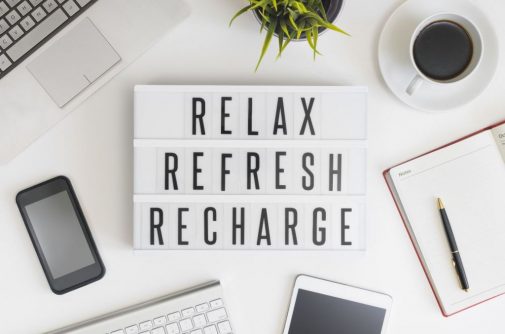How to create a self-care routine that sticks

You can’t pour from an empty cup. Take care of yourself first.
How many times have you heard some version of that statement? Sayings like that are everywhere, from inspirational Pinterest Boards to the well-known “place the oxygen mask over your mouth before helping others” phrase each time you board an airplane.
Although it’s long been said that you can’t take care of others to the best of your ability if you aren’t functioning optimally ourselves, many individuals struggle with making self-care a priority.
For every reason people find to not practice self-care – from time, to money, to feeling guilty, to fears of being perceived as selfish or not working hard enough – there is a reason to practice self-care, with a main one being if you want to be the best partner, parent or co-worker you can be, you need to take time to recharge and connect with ourselves to determine what you really want out of life, which will help improve quality of life over time.
So, what is a self-care routine, and how do you create one?
“A self-care routine is an attainable plan you make to improve your personal well-being. It can include wellness components like age-appropriate health screenings with your physician, an exercise and nutrition program, sleep schedule, stress management techniques, social events and even financial wellness planning,” says Kristen Turner, a health navigator at Advocate Lutheran General Hospital in Park Ridge, Ill.
Self-care routines are as individual as the people who create them. Since there is no one-size fits-all formula, Turner says it’s essential to identify activities and goals that are important to you and develop a plan to incorporate them into your life on a daily or weekly basis until they become routine. Keep in mind that self-care plans can include a wide variety of activities, including exercise, nutrition planning, social gatherings, private time, listening to music, sleeping or anything that helps you recharge.
“Discovering your self-care plan is identifying what helps you feel most balanced despite your busy lifestyle,” says Turner.
When figuring out what routine is right for you, keep the following in mind:
Choose activities you enjoy
A lot has been written about the benefits of yoga, meditation or running, but if you don’t enjoy those activities, don’t incorporate them into your self-care routine. Not only will you feel stressed about trying to fit in activities you feel you “should” be doing, you’ll also be less likely to maintain your self-care routine if it doesn’t mesh with your interests. If you want to develop a self-care routine that sticks, identify what you want to prioritize – physical health, relationships, financial goals, etc. – and develop a plan to reach your goals.
“For example, if it’s important to you to manage your stress, write down some things that you would like to do to identify stressful situations followed by coping skills,” says Turner. “Next, make your routine specific. For example, you notice that exercise helps reduce your stress. Carve out specific days and time each week to commit to exercise followed by stretching and meditation.”
Choose activities that touch on multiple wellness dimensions
Self-care routines come in all shapes and sizes, but what many of the activities have in common – from practicing yoga to playing a team sport to enjoying a good book or movie – is that they all fall into one or more of the six dimensions of wellness. The most commonly referred to dimensions of wellness are physical, social, intellectual, spiritual, emotional and occupational. A few wellness models also include financial and environmental factors in their dimensions, as well. Make activities that fall into one or more of these buckets part of your self-care routine. For example, joining an intramural soccer team or tennis league checks the physical and social boxes, and joining a book club would check both the intellectual and social boxes.
Make a “date” with self-care
Sometimes, it seems like if it’s not on your calendar or to-do list, it doesn’t happen. You block off time for important meetings, work events and special occasions with friends and family, so why not add self-care to the schedule, as well? Determine how much time per week you’ll dedicate to seeing people and doing things that help you destress and feel refreshed. You can certainly block off a few hours over the weekend to hang out at the beach or have dinner with friends, but remember you can also set aside 15 or 20-minute increments of time during the week to read before bed, take a bath or sit in meditation. The activity doesn’t matter as much as making a date for self-care with yourself and sticking to it.
If at first you don’t succeed…keep trying!
Developing a self-care plan that will eventually become a way of life takes time and trial and error. If your first plan doesn’t work, that’s okay. Through experimentation, you’ll find what works for you. Turner says one of the most common reasons people fall off a self-care routine is that they create unattainable goals when first developing their plan.
“To accomplish small tasks that turn into long-term lifestyle habits, you must first be as realistic as possible. Identify barriers and opportunities and develop a plan. If for some reason you can’t stick to your plan, know that it is okay to make changes and try again,” says Turner.
Remember, consistency is key when trying to form new habits. To help you stay on your game, Turner recommends finding a support system that can keep you accountable to your goals and help you when you’re struggling to stay on track.
Related Posts
Comments
About the Author
Colette A. Harris, health enews contributor, is the public affairs and marketing coordinator at Advocate Lutheran General Hospital in Park Ridge, Il. She holds a Master of Science degree in journalism from Northwestern’s Medill School of Journalism and has nearly a decade of experience writing about health and wellness, which are her passions. When she’s not writing, you can find her practicing yoga, cooking, reading, or traveling.

















